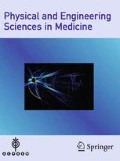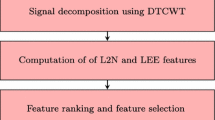Abstract
The alcoholism can be detected by analyzing electroencephalogram (EEG) signals. However, analyzing multi-channel EEG signals is a challenging task, which often requires complicated calculations and long execution time. This paper proposes three data selection methods to extract representative data from the EEG signals of alcoholics. The methods are the principal component analysis based on graph entropy (PCA-GE), the channel selection based on graph entropy (GE) difference, and the mathematic combinations channel selection, respectively. For comparison purposes, the selected data from the three methods are then classified by three classifiers: the J48 decision tree, the K-nearest neighbor and the Kstar, separately. The experimental results show that the proposed methods are successful in selecting data without compromising the classification accuracy in discriminating the EEG signals from alcoholics and non-alcoholics. Among them, the proposed PCA-GE method uses only 29.69 % of the whole data and 29.5 % of the computation time but achieves a 94.5 % classification accuracy. The channel selection method based on the GE difference also gains a 91.67 % classification accuracy by using only 29.69 % of the full size of the original data. Using as little data as possible without sacrificing the final classification accuracy is useful for online EEG analysis and classification application design.







Similar content being viewed by others
References
Haas LF (2003) Hans Berger (1873–1941), Richard Caton (1842–1926), and electroencephalography. J Neurol Neurosurg Psychiatr 74(1):9–9
Lehnertz K, Elger CE (1998) Can Epileptic seizures be predicted? Evidence from nonlinear time series analysis of brain electrical activity. Phys Rev Lett 80(22):5019–5022
Martinerie J, Adam C, Quyen MLV, Baulac M, Clemenceau S, Renault B, Varela FJ (1998) Epileptic seizures can be anticipated by non-linear analysis. Nat Med 4(10):1173–1176
Siuly S, Kabir E, Wang H, Zhang Y (2015) Exploring sampling in the detection of multicategory EEG signals. Computat Math Methods Med 2015:576437. doi:10.1155/2015/576437
Siuly LY, Wen P (2011) EEG signal classification based on simple random sampling technique with least square support vector machine. Int J Biomed Eng Technol 7(4):390–409. doi:10.1504/IJBET.2011.044417
Zhu G, Li Y, Wen P (2011) Evaluating functional connectivity in alcoholics based on maximal weight matching. J Adv Comput Intell Intell Inform 15(9):1221–1227
Wackermann J (1995) Beyond mapping: estimating complexity of multichannel EEG recordings. Acta Neurobiol Exp 56(1):197–208
Zhu G, Li Y, Wen PP (2012) An efficient visibility graph similarity algorithm and its application on sleep stages classification. Brain Informatics. Springer, New York, pp 185–195
Stam C, Lelj EHVD, Keunen R, Tavy D (1999) Nonlinear EEG changes in postanoxic encephalopathy. Theory in Biosciences-Theorie in den Biowissenschaften 118(3–4):209–218
Stam CJ, Van Woerkom T, Keunen R (1997) Non-linear analysis of the electroencephalogram in Creutzfeldt-Jakob disease. Biol Cybern 77(4):247–256
Nguyen-Ky T, Wen P, Li Y, Malan M (2012) Measuring the hypnotic depth of anaesthesia based on the EEG signal using combined wavelet transform, eigenvector and normalisation techniques. Comput Biol Med 42(6):680–691
Li T, Wen P, Jayamaha S (2014) Anaesthetic EEG signal denoise using improved nonlocal mean methods. Australas Phys Eng Sci Med 37(2):431–437
Misulis KE, Spehlmann R (1994) Spehlmann’s evoked potential primer: visual, auditory, and somatosensory evoked potentials in clinical diagnosis. Butterworth-Heinemann Medical, Boston
Oscar-Berman M, Marinković K (2007) Alcohol: effects on neurobehavioral functions and the brain. Neuropsychol Rev 17(3):239–257
Richman JS, Moorman JR (2000) Physiological time-series analysis using approximate entropy and sample entropy. Am J Physiology-Heart Circ Physiol 278(6):H2039–H2049
Di W, Zhihua C, Ruifang F, Guangyu L, Tian L Notice of Retraction Study on human brain after consuming alcohol based on EEG signal. In: Computer science and information technology (ICCSIT), 2010 3rd IEEE international conference on 2010. IEEE, pp 406–409
Sun Y, Ye N, Xu X EEG analysis of alcoholics and controls based on feature extraction. In: Signal processing, 2006 8th international conference on 2006 IEEE
Subasi A (2007) EEG signal classification using wavelet feature extraction and a mixture of expert model. Expert Syst Appl 32(4):1084–1093
Güler I, Übeyli ED (2005) Adaptive neuro-fuzzy inference system for classification of EEG signals using wavelet coefficients. J Neurosci Methods 148(2):113–121
Tsuji T, Bu N, Fukuda O, Kaneko M (2003) A recurrent log-linearized Gaussian mixture network. Neural Netw IEEE Trans 14(2):304–316
Vasicek O (1976) A test for normality based on sample entropy. J R Stat Soc Ser B (Methodol) 38:54–59
Polat K, Güneş S (2007) Classification of epileptiform EEG using a hybrid system based on decision tree classifier and fast Fourier transform. Appl Math Comput 187(2):1017–1026
Chandaka S, Chatterjee A, Munshi S (2009) Cross-correlation aided support vector machine classifier for classification of EEG signals. Expert Syst Appl 36(2):1329–1336
Zhu G, Li Y, Wen PP, Wang S (2014) Analysis of alcoholic EEG signals based on horizontal visibility graph entropy. Brain Inform 1:1–7
Tomida, Naoki et al. Active Data selection for motor imagery EEG classification. Biomed Eng, IEEE Trans 62.2 (2015): 458–467
Bache K, Lichman M (2013) UCI machine learning repository. URL http://archive.ics.uci.edu/ml, vol 901
Gutin G, Mansour T, Severini S (2011) A characterization of horizontal visibility graphs and combinatorics on words. Phys A 390(12):2421–2428
Luque B, Lacasa L, Ballesteros F, Luque J (2009) Horizontal visibility graphs: exact results for random time series. Phys RevE 80(4):046103
Diestel R (2005) Graph theory, 3rd edn. Springer, Berlin, New York
Körner J (1973) Coding of an information source having ambiguous alphabet and the entropy of graphs. In: 6th Prague conference on information theory, pp 411–425
Shannon CE (2001) A mathematical theory of communication. ACM SIGMOBILE Mobile Comput Commun Rev 5(1):3–55
Person K (1901) On lines and planes of closest fit to systems of points in space. Philos Mag 2(6):559–572
Hotelling H (1933) Analysis of a complex of statistical variables into principal components. J Educ Psychol 24(6):417
Salzberg SL (1994) C4. 5: programs for machine learning by j. ross quinlan. morgan kaufmann publishers, inc., 1993. Mach Learn 16(3):235–240
Sehgal L, Mohan N, Sandhu PS (2012) Quality prediction of function based software using decision tree approach. In: International conference on computer engineering and multimedia technologies (ICCEMT), pp 43–47
Duda RO, Hart PE (1973) Pattern classification and scene analysis, vol 3. Wiley, New York
Author information
Authors and Affiliations
Corresponding author
Rights and permissions
About this article
Cite this article
Wang, S., Li, Y., Wen, P. et al. Data selection in EEG signals classification. Australas Phys Eng Sci Med 39, 157–165 (2016). https://doi.org/10.1007/s13246-015-0414-x
Received:
Accepted:
Published:
Issue Date:
DOI: https://doi.org/10.1007/s13246-015-0414-x




